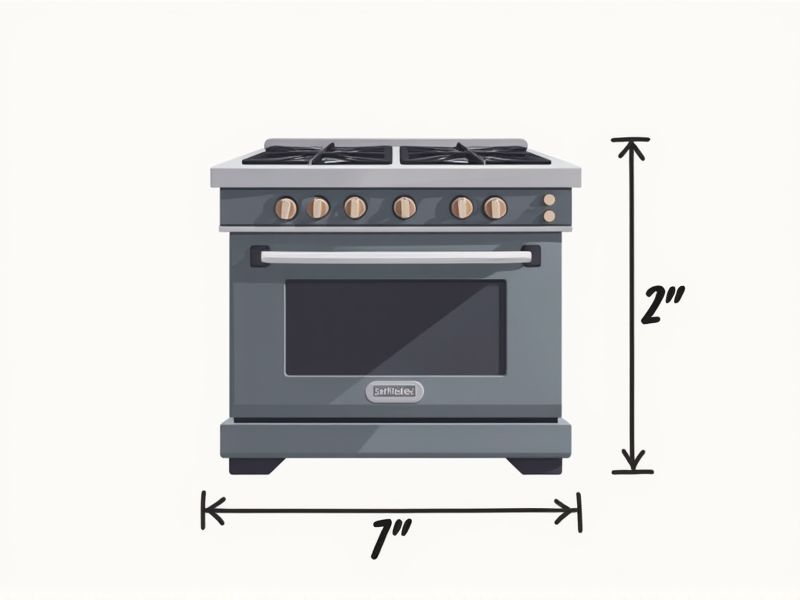
When selecting a stove for your kitchen, knowing the standard dimensions is essential for a proper fit. Most freestanding or slide-in stoves are typically 30 inches wide, 25-27 inches deep, and around 36 inches high, which aligns with standard countertop heights for seamless installation. Compact or apartment-sized stoves are often narrower, measuring about 20-24 inches wide, while professional-style or high-capacity models may be available in 36-inch or even 48-inch widths. Always measure your available space and check the manufacturer's specifications to ensure the new stove fits comfortably in your kitchen layout.
Typical Width Options: 30, 36, Or 48 Inches
The standard width options for stoves typically include 30, 36, and 48 inches, catering to various kitchen sizes and cooking needs. A 30-inch stove often fits smaller kitchens while providing adequate cooking surface and multiple burners. The 36-inch model strikes a balance between space efficiency and enhanced cooking capacity, making it suitable for moderate-sized kitchens. For those who frequently entertain or cook large meals, a 48-inch stove offers ample cooking space, often featuring additional burners or dual ovens for maximum versatility.
Average Depth: 25 To 27 Inches
The average depth of a standard stove ranges from 25 to 27 inches, making it crucial to measure your kitchen space accurately for proper fit. This depth accommodates most cooking appliances while ensuring ease of access and usability during meal preparation. A stove within this measurement can seamlessly integrate into your kitchen design and layout. Consider this dimension when planning renovations to optimize your cooking experience and maintain functionality.
Height To Cooking Surface: Approximately 36 Inches
The standard height of a stove's cooking surface is approximately 36 inches, making it suitable for most kitchen designs and user ergonomics. This height allows for comfortable cooking without excessive bending or stretching. If you are planning a kitchen remodel, consider this measurement to ensure that the stove fits well with your countertops, often set at a similar height. Achieving the ideal stove height can enhance your cooking experience and contribute to an efficient kitchen layout.
Common Oven Interior Width: 25 Inches
A standard stove typically features a common oven interior width of 25 inches, providing ample space for various cooking tasks. This measurement allows for the accommodation of multiple cookware sizes, from large roasting pans to standard baking sheets. With an interior volume that averages around 3.5 to 5.0 cubic feet, these ovens are suitable for everyday meals and larger gatherings alike. You can optimize your cooking experience by selecting racks that adjust easily to fit your specific culinary needs.
Cooktop Burner Spacing: Usually 4-6 Inches Apart
Cooktop burner spacing is crucial for efficient cooking, typically ranging from 4 to 6 inches apart. This spacing ensures optimal heat distribution and reduces the risk of pots and pans overlapping, which can lead to uneven cooking. For your home kitchen, consider a layout that maximizes this distance to improve your culinary experience. Proper burner spacing also allows you to multitask, enabling the simultaneous use of multiple pots for different dishes, enhancing overall meal preparation efficiency.
Freestanding And Slide-In Options
Freestanding stoves occupy approximately 30 inches in width and are designed for easy installation, making them ideal for any kitchen layout. In contrast, slide-in stoves offer a seamless look by fitting flush with countertops, typically measuring 30 inches wide, providing a modern aesthetic. Both types often come equipped with five burners, including a dual ring for greater heat control, catering to your diverse cooking needs. Energy efficiency ratings for these appliances can range from 80% to over 90%, ensuring minimal electricity consumption while maximizing performance.
Compact Models For Smaller Spaces
Compact stoves are ideal for smaller spaces, efficiently utilizing limited kitchen real estate without compromising functionality. Many models range from 20 to 24 inches in width, allowing versatility in placement while offering standard cooking features. Some compact stoves come equipped with four burners and a spacious oven, ensuring you can prepare multiple dishes simultaneously. When considering energy efficiency, look for models that meet ENERGY STAR(r) ratings for reduced utility costs and increased sustainability.
Ada Compliant Models Available
When considering a stove that meets ADA compliance standards, prioritize models designed with user accessibility in mind, including features like front-mounted controls and adjustable height options. Many ADA-compliant stoves offer specific measurements, such as a countertop height of 34 inches or lower, to ensure ease of use for individuals with mobility impairments. You might also look for stoves with visual or tactile indicators to assist users with limited sight or dexterity. The investment in an ADA-compliant model not only enhances safety but also improves the overall cooking experience for diverse users.
Depth (With Handle): Up To 30 Inches
A standard stove typically boasts a depth of up to 30 inches, accommodating various kitchen layouts and design preferences. When selecting a stove, consider the dimensions, including the handle's protrusion, as it can affect accessibility and clearance in smaller spaces. This measurement ensures compatibility with standard kitchen cabinetry, enabling efficient use of storage areas. Your choice of stove depth can also impact countertop space, affecting kitchen workflow and ease of use.
Consideration For Venting Or Hood Placement
When selecting a stove, consider the importance of proper venting and hood placement to ensure optimal kitchen air quality and safety. A range hood should ideally be placed 24 to 36 inches above the cooking surface, providing adequate ventilation for effective smoke and odor removal. Ensure that your hood has a minimum airflow rating of 300 CFM to efficiently manage the emissions from high-heat cooking methods. Proper venting not only enhances performance but also contributes to energy efficiency, potentially reducing your overall utility bills.
